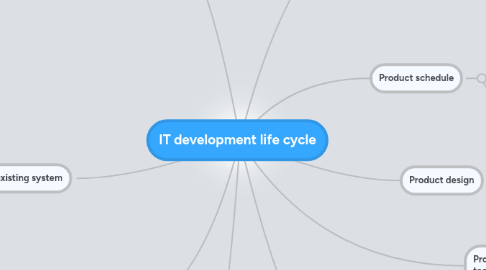
1. Investigation of the existing system
1.1. They here look for any problems in the existing system and if they can solve tht problem
2. Waterfall model
2.1. Requirement Analysis phase
2.1.1. Looking at current system
2.1.1.1. To see what the problem is
2.1.2. Looking for how to solve this
2.1.3. Looking for the requirements
2.1.3.1. What are the requirements of the new IT system
2.2. Design phase
2.2.1. propose ideas to solve the issue
2.2.1.1. Different ideas can arise
2.2.2. client approval
2.2.3. identify the requirements of the new IT system
2.2.3.1. How is can the team build the IT system and how does the end user use it
2.2.4. select hardware and software to use and develop IT system
2.3. Implementation phase
2.3.1. Developing the new IT system
2.3.2. Documentation
2.3.2.1. How the IT system is developed
2.3.2.1.1. Used for the maintenance phase
2.3.3. Feedback from client
2.3.3.1. To see if the new IT system is what the client wanted
2.3.4. switching old IT system to new IT system
2.3.5. Alpha and beta testing
2.3.5.1. Alpha testing is where the team does the testing like extreme data, normal data and invalid data
2.3.5.2. Beta testing is where the end users test the IT system and give regular feedback
2.4. Evaluation/verification
2.4.1. Client evaluation
2.4.1.1. If the client is satisfied with the new developed IT system
2.4.2. End-user evaluation
2.4.2.1. If this meets the end-users expectations
2.5. Maintenance phase
2.5.1. Fix glitches and bugs
2.5.2. Regular updates, to optimize IT system
2.5.3. Maintenance staff
3. Feasibility study
3.1. This study is to check if it is possible to make the new system
3.2. They check costs, time, staff, etc
4. Requirements specifications
4.1. In this stage they set the requirements of the new system, what it has to be able to do
5. IT personnel in an organisation
5.1. Maintenance staff
5.1.1. Support staff
5.1.1.1. Help solving minor issues
5.1.2. Database administrator
5.1.2.1. Maintaining database, checking data and performance
5.1.3. Network manager
5.1.3.1. Supporting and managing business networks
5.1.4. Information System Manager
5.1.4.1. Maintaining the computers within the companies, like doing backups or installing new software
5.2. Developing staff
5.2.1. Designer
5.2.1.1. Designs how the IT system looks like and how it is build up
5.2.2. Manager
5.2.2.1. This person leads the team, make them work together
5.2.3. programmer
5.2.3.1. Programs the IT system, making the codes of the IT system
5.2.4. Analyst
5.2.4.1. Analyses the issue involving the old IT system
6. Product schedule
6.1. Setting deadlines
6.2. A map to developing the new system
7. Product design
7.1. The requirement analysis is converted to a detailed plan explaining how to build the new system
8. Product development and technical documentation
8.1. This stages starts the developing of the product
9. Client and end-user evaluation, integration
9.1. Testing
9.1.1. Alpha testing
9.1.1.1. This is where the developers test the system themselves, like looking if it can recognize normal, extreme and invalid data.
9.1.2. Acceptance testing
9.1.2.1. this is to see if it makes the consumers expectation
9.1.3. Black box testing
9.1.3.1. To test if it works as it should
9.1.4. Compatibility testing
9.1.4.1. If it can be used with different system
9.1.5. Conformance testing
9.1.5.1. If the product meets the standards, so that the product is compatible and portable with other systems
9.1.6. Performance testing
9.1.6.1. If it can handle heavy users loads, how well it can perform in these conditions
9.1.7. Functionality testing
9.1.7.1. All the functions are tested in this process
9.1.8. System tesing
9.1.8.1. Overall system testing
9.1.9. White box testing
9.1.9.1. Internal workings are tested, like html codes in websites
9.1.10. Beta testing
9.1.10.1. This is where the product is tested by the end users themselves, they give feedback whenever there is a problem with the functionality of the product, like for instance different bugs and glitches within the product.
